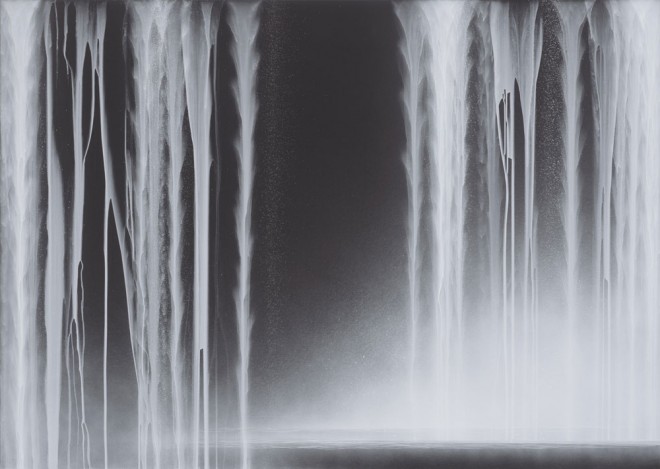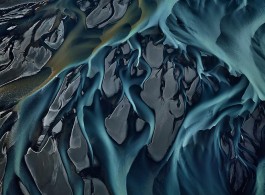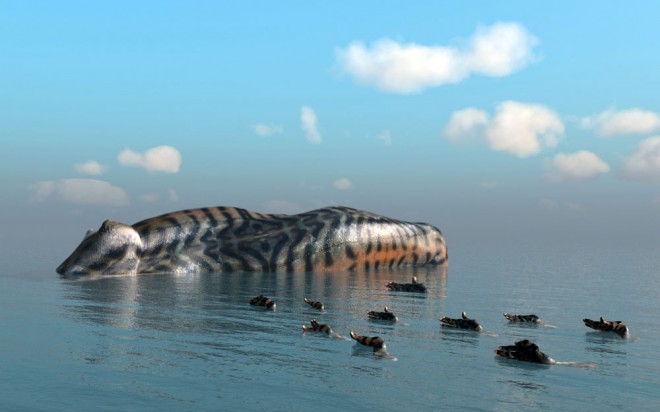Press Release
Hong Kong, December 2, 2013—Sundaram Tagore Hong Kong is pleased to present Natural Selection, an exhibition that brings together the work of four radically different artists who share a deep-rooted connection to the natural world.
Acclaimed Canadian photographer EDWARD BURTYNSKY chronicles the human impact on nature in his disarmingly beautiful images of industrial landscapes around the globe.
Photographs from Water, Burtynsky’s most recent series, begun in 2007, document the scale and impact of manufacturing and consumption on the world’s water supplies. In stunning color and intricate detail, he shows how human interference is depleting this precious resource, leading to devastated landscapes that are polluted, manipulated and exhausted.
More abstract and painterly than his previous work, some of the images no longer even register as photographs. Burtynsky shot the images from 7,000 feet above in order to bring the scale of the human imprint on the landscape into perspective.
Edward Burtynsky’s works are in the collections of more than fifty museums worldwide, including the Museum of Modern Art and the Solomon R. Guggenheim Museum, New York; Bibliothèque Nationale, Paris; The Photographer’s Gallery and the Victoria and Albert Museum, London; and Albright-Knox Art Gallery, Buffalo, New York. Burtynsky was recognized with a TED award in 2005. In 2006 he was named an Officer of the Order of Canada, the nation’s highest civilian honor. He holds four honorary doctorate degrees and his distinctions include the National Magazine Award, the MOCCA award, the Outreach Award at the Rencontres d’Arles and the Applied Arts Magazine book award.
In 2007, Burtynsky was the subject of the award-winning documentary Manufactured Landscapes, which screened at the Sundance Film Festival. His new film, Watermark, which premiered at this year’s Toronto International Film Festival, follows Burtynsky as he takes the photographs that form the Water series. These photographs were recently published in a book of the same name by the German publishing house Steidl.
RICARDO MAZAL, one of Mexico’s most prominent contemporary painters, explores themes of life, death, transformation and regeneration through a multidisciplinary approach to painting that combines photography and digital technology.
In 2004, Mazal embarked on a decade-long examination of the sacred burial rituals of three cultures: the Mayan tomb of The Red Queen in Mexico, the Peace Forest cemetery in Germany and the sacred sky burials of Mount Kailash in Tibet.
Mazal merges elements from the natural world observed in his studies, such as horizontal bands of black and white from the snow-streaked surfaces of Mount Kailash or bold swaths of crimson cut with muted tones of sepia, violet and gray inspired by the trees found in the Peace Forest. The resulting images are an amalgamation of kinetic geometric forms, amplified by the large scale of the canvases.
Ricardo Mazal’s work is included in the collections of the Scottsdale Museum of Contemporary Art, Arizona; Museo de Arte Moderno, Mexico City; Museo de Arte Abstracto Manuel Felguérez, Zacatecas, Mexico; Maeght Foundation, Paris; and Deutsche Bank, New York and Germany. In 2006, a retrospective of his work was held at the Museo de Arte Moderno, Mexico City.
Noted worldwide for his sublime waterfall and cliff images, often monumental in scale, renowned Japanese painter HIROSHI SENJU combines a minimalist visual language rooted in Abstract Expressionism with ancient painting techniques unique to Japan.
Widely recognized as one of the few contemporary masters of the thousand-year-old Nihonga style of painting, Senju uses mineral pigments made from ground stone, shell and corals and animal-hide glue binders. With incredible delicacy, he pours translucent paint onto mulberry paper mounted on board, creating the sensation of unrestrained movement. Evoking a deep sense of calm, his waterfalls conjure not just the appearance of rushing water, but also its sound, smell and feel.
Hiroshi Senju’s work is in the Museum of Contemporary Art in Los Angeles; The Museum of Modern Art, Toyama, Japan; Yamatane Museum of Art in Tokyo; The Tokyo National University of Fine Arts and Music; the San Francisco Museum of Modern Art; and the Kushiro Art Museum, Hokkaido, Japan. The recently opened Hiroshi Senju Museum in Karuizawa, Japan, designed by Pritzker Prize winner Ryue Nishizawa, is home to more than one hundred works by the artist. Tokyo’s Haneda Airport features a monumental mural by Hiroshi Senju.

Hiroshi Senju, “Falling Water,” 2013, acrylic and fluorescent pigments on Japanese mulberry paper, 63.8 x 89.5 inches
KIM JOON, one of Korea’s most notable young contemporary artists, creates digital prints exploring themes of desire, memory and youth using porcelain, tattoos, and most recently, islands. A master of the computer software 3D Studio Max, Kim successfully juxtaposes old and new, traditional Asian motifs and new media.
In his latest series, Island, the artist explores the volatile relationship between humanity and nature. This dramatic shift in focus away from tattoos and luxury was spurred by two recent events in Joon’s life: witnessing the Fukushima Daiichi nuclear disaster, which happened close to his home, and a visit to the volcanic island of Jeju, considered one of the most beautiful and mystical islands in Korea. For Joon, the juxtaposition of these two experiences provoked an examination of the relationship between nature and humanity and the paradox of the fragility and strength of life.
Joon’s stunningly rendered images depict a series of islands seemingly created from fragmented human bodies mapped by exotic animal skins, poised to unfurl as they rise from the ocean. The bodies raise the question whether damaged lives can be repaired if humanity tries to create harmony with nature.
Kim Joon’s works have been exhibited at the Saatchi Gallery, London (where his work was featured on the cover of Korean Eye: Contemporary Korean Art, the book accompanying the exhibition); Total Museum, Seoul, Korea; The National Museum of Contemporary Art, Kwachon, Korea; and the National Taiwan Museum.




